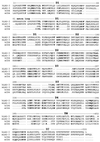Characterization of the major histocompatibility complex class II binding site on LAG-3 protein
- PMID: 9159144
- PMCID: PMC20850
- DOI: 10.1073/pnas.94.11.5744
Characterization of the major histocompatibility complex class II binding site on LAG-3 protein
Abstract
The lymphocyte activation gene-3 (LAG-3), selectively transcribed in human activated T and NK cells, encodes a ligand for major histocompatibility complex (MHC) class II molecules. Like CD4, LAG-3 ectodomain is composed of four Ig-like domains (D1-D4). Nothing is known about the LAG-3 regions or residues required to form a stable MHC class II binding site. In contrast to CD4, soluble LAG-3 molecules stably interact with MHC class II molecules expressed on the cell surface. In addition, the first two N-terminal domains of soluble LAG-3 (D1 and D2) molecules, alone, are capable of binding MHC class II. From a LAG-3 model structure, we designed mutants and tested their ability to bind MHC class II molecules in an intercellular adhesion assay. We found residues on the membrane-distal, CDR1-2-containing top face of D1 that are essential for either binding or repulsing MHC class II proteins. Most of these residues are clustered at the base of a large extra-loop structure that is a hallmark of the LAG-3 D1 Ig-like domain. In addition, as for CD4, oligomerization of LAG-3 on the cell surface may be required to form a stable MHC binding site because mutation of three residues in the ABED beta-strands containing side of D1 results in a dominant negative effect (i.e., binding inhibition of coexpressed wild-type LAG-3).
Figures




References
Publication types
MeSH terms
Substances
Associated data
- Actions
LinkOut - more resources
Full Text Sources
Other Literature Sources
Molecular Biology Databases
Research Materials

